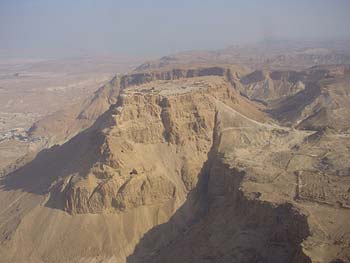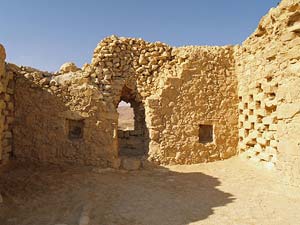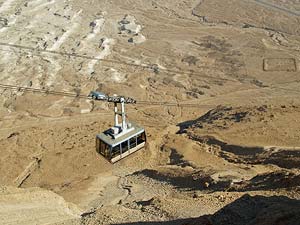Masada
 |
| Masada National Park |
Masada is the name for a site of ancient palaces and fortifications in the South District of Israel on top of an isolated rock plateau, or large mesa, on the eastern edge of the Judean Desert overlooking the Dead Sea. Masada became famous after the First Jewish-Roman War (also known as the Great Jewish Revolt) when a siege of the fortress by troops of the Roman Empire may have led to a mass suicide of the site's Jewish Sicarii fugitives when defeat became imminent. Today, Masada is a very popular tourist destination.
Geography
The cliffs on the east edge of Masada are about 1,300 feet (400 m) high and the cliffs on the west are about 300 feet (90 m) high; the natural approaches to the cliff top are very difficult. The top of the plateau is flat and rhomboid-shaped, about 1,800 feet (550 m) by 900 feet (275 m). There was a casemate wall around the top of the plateau totaling 4,300 feet (1.3 km) long and 12 feet (3.7 m) thick, with many towers, and the fortress included storehouses, barracks, an armory, the palace, and cisterns that were refilled by rainwater. Three narrow, winding paths led from below up to fortified gates.
History
According to Josephus, a first-century Jewish Roman historian, Herod the Great fortified Masada between 37 and 31 BCE as a refuge for himself in the event of a revolt. In 66 CE, at the beginning of the First Jewish-Roman War against the Roman Empire, a group of Judaic extremist rebels called the Sicarii took Masada from the Roman garrison stationed there. For the next two years, the Sicarii used Masada as their base for raiding and pillaging Roman and Jewish settlements alike.
 |
Dovecote at Masada |
The works of Josephus are contested. But nevertheless, are the sole record of events that took place during the siege. According to modern interpretations of Josephus, the Sicarii were an extremist splinter group of the Zealots who were equally antagonistic to both Romans and other Jewish groups. The Zealots (according to Josephus), in contrast to the Sicarii, carried the main burden of the rebellion, which opposed Roman rule of Judea (as the Roman province of Iudaea, its Latinized name).
The Sicarii on Masada were commanded by Elazar ben Ya'ir (who may have been the same person as Eleazar ben Simon), and in 70 CE they were joined by additional Sicarii and their families that were expelled from Jerusalem by the Jewish population with whom the Sicarii were in conflict shortly before the destruction of Jerusalem and the Second Temple.
Archaeology indicates that they modified some of the structures they found there; this includes a building which was modified to function as a synagogue facing Jerusalem, (in fact, the building may originally have been one), although it did not contain a mikvah or the benches found in other early synagogues. Remains of two mikvahs were found elsewhere on Masada.
In 72, the Roman governor of Iudaea Lucius Flavius Silva marched against Masada with the Roman legion X Fretensis and laid siege to the fortress. After failed attempts to breach the wall, they built a circumvallation wall and then a rampart against the western face of the plateau, using thousands of tons of stones and beaten earth.
Josephus does not record any attempts by the Sicarii to counterattack the besiegers during this process, a significant difference from his accounts of other sieges against Jewish fortresses. He did record a raid on a nearby Jewish settlement called Ein-Gedi during the siege, where the Sicarii killed 700 of its inhabitants.
Some historians also believe that Romans may have used Jewish slaves to build the rampart, whom the Zealots (these historians see them as Zealots rather than Sicarii) were reluctant to kill because of their beliefs; however, as sicarii believed that Jews who did not belong to their sect could be robbed and killed with impunity this is disputed. According to Dan Gill, geological observations in the early 1990s revealed that the 375-foot (114 m) high assault ramp consisted mostly of a natural spur of bedrock that required a ramp only 30 feet (9.1 m) high built atop it in order to reach the Masada defenses. This discovery would diminish both the scope of the construction and of the conflict between the Sicarii and Romans, relative to the previous perspective in which the ramp was an epic feat of construction.
The rampart was complete in the spring of 73, after approximately two to three months of siege, allowing the Romans to finally breach the wall of the fortress with a battering ram on April 16. When they entered the fortress, however, the Romans discovered that its 936 inhabitants had set all the buildings but the food storerooms ablaze and committed mass suicide rather than face certain capture, defeat, slavery or execution by their enemies.
The account of the siege of Masada was related to Josephus by two women who survived the suicide by hiding inside a cistern along with five children, and repeated Elazar ben Yair's exhortations to his followers, prior to the mass suicide, verbatim to the Romans. Because Judaism strongly discourages suicide, Josephus reported that the defenders had drawn lots and killed each other in turn, down to the last man, who would be the only one to actually take his own life. This account, too, may be at issue, however, since Judaism also discourages murder and some historians believe the suicide account to be an invention by Josephus. They claim suicide is unlikely as the defenders had neither the opportunity nor the unanimity required. Josephus says that Eleazar ordered his men to destroy everything except the foodstuffs to show that the defenders retained the ability to live, and so chose the time of their death over slavery but archaeological excavations have shown that storerooms which contained their provisions were burnt. Josephus also reported that the Romans found arms sufficient for ten thousand men as well as iron, brass and lead which casts further doubt on the account. Historians also point out the parallels between the incidents at Jotapata and Masada such as Eleazar's second speech corresponding to the speech which Josephus himself delivered at Jotapata under similar circumstances and the transference of the lottery motif from the former to the latter.
There is significant disagreement among historians as to the veracity of the Josephus story. Josephus had only claimed to have heard the story second-hand himself. There is also considerable controversy in the archaeological reporting. The primary archeologist, Yigael Yadin, has recently come under charges of professional misconduct. After extensively studying Yadin's work documents, transcripts, and conversations, Ben-Yehuda concluded that Yadin conducted "a scheme of distortion which was aimed at providing Israelis with a spurious historical narrative of heroism" The actual record shows evidence of "different factions of Jews fighting and killing each other, of collective suicide by a group of terrorists and assassins whose "fighting spirit" was questionable. In addition to the work of Ben-Yehuda, there are the admissions of falsification by Yadin himself. While Yadin had put the number of human remains at 25 and claimed "they can only be those of the defenders of Masada," he later admitted he was pressured by the Israeli government to make that connection, even though the cave contained pig bones among the skeletons, a common sacrificial burial practice for Roman dead. This admission, in light of the undisputed fact that a Roman garrison was stationed on the Masada summit for some thirty years after its conquest, strongly suggest that the Romans would have disposed of the bodies in one way or another, and likely used the cave for burial of their own.
Masada Today
 |
A cable car heading down from Masada |
The site of Masada was identified in 1842 and extensively excavated between 1963 and 1965 by an expedition led by Israeli archeologist Yigael Yadin. A pair of cable cars now carry those visitors who do not wish to climb the ancient, now restored, Snake Path, on the eastern side of the mountain (access via the Dead Sea road). Due to the remoteness from human habitation and its arid environment, the site has remained largely untouched by humans or nature during the past two millennia. The Roman ramp still stands on the western side and can be climbed on foot. Many of the ancient buildings have been restored from their remains, as have the wall-paintings of Herod's two main palaces, and the Roman-style bathhouses that he built. The synagogue, storehouses, and houses of the Jewish rebels have also been identified and restored. The meter-high circumvallation wall that the Romans built around Masada can be seen, together with eleven barracks for the Roman soldiers just outside this wall. Water cisterns two-thirds of the way up the cliff drain the nearby wadis by an elaborate system of channels, which explains how the rebels managed to have enough water for such a long time.
Inside the synagogue, an ostracon bearing the inscription me'aser kohen (tithe for the priest) was found, as were fragments of two scrolls; parts of Deuteronomy 33-34 and parts of Ezekiel 35-38 (including the vision of the "dry bones"), found hidden in pits dug under the floor of a small room built inside the synagogue. In other loci fragments were found of the books of Genesis, Leviticus, Psalms, and Sirach, as well as of the Songs of the Sabbath Sacrifice.
In the area in front of the northern palace, eleven small ostraca were recovered, each bearing a single name. One reads "ben Yair" and could be short for Eleazar ben Yair, the commander of the fortress. It has been suggested that the other ten names are those of the men chosen by lot to kill the others and then themselves, as recounted by Josephus.
 |
The large bathhouse at the top of Masada |
Archaeologist Yigael Yadin's excavations have so far uncovered the remains of 28 people at Masada. The remains of three people, a male 20-22 years of age, a female 17-18 and a child approximately 12 years old, were found in the palace and the remains of 25 people were found in a cave at the base of the cliff. Carbon dating of textiles found with the remains in the cave indicate they are contemporaneous with the period of the Revolt and the remains of pigs that were found with them, which Romans sacrificed at burials, could be an indication the grave is Roman. All the remains were reburied at Masada with full military honours on July 7, 1969.
The remnants of a Byzantine church dating from the 5th and 6th centuries, have also been excavated on the top of Masada. The Masada story has been used in a similar context by the British Mandate of Palestine, which planned the Masada plan to man defensive positions on Mount Carmel with Palmach fighters, in order to stop Erwin Rommel's expected drive through the region in 1942. The plan was abandoned following Rommel's defeat at El Alamein.
Inspired by the Sicarii resistance to the Romans at Masada, the Chief of Staff of the Israel Defence Forces (IDF) Moshe Dayan initiated the regular practice of the troops finishing their Tironut (IDF basic training) with a pilgrimage to and swearing-in ceremonies on Masada, where they swear the oath that "Masada shall never fall again." Hundreds of Israeli soldiers have climbed at night in rows via the Snake Path, and then were sworn in with torches lighting the background. This was customary for troops of the Israeli Armor Corps, the Givati Brigade and others. Marches to Masada are still popular in the IDF, and a requirement for many units, such as Nahal.
Masada has been a UNESCO World Heritage Site since 2001. An audio-visual light show is presented nightly on the western side of the mountain (access by car from the Arad road or by foot, down the mountain via the Roman ramp path).
In 2007, a new museum opened at the site in which archeological findings are displayed within a theatrical setting.
A 2,000-year-old seed discovered during archaeological excavations in the early 1960s has been successfully germinated to become a date plant, the oldest known such germination.